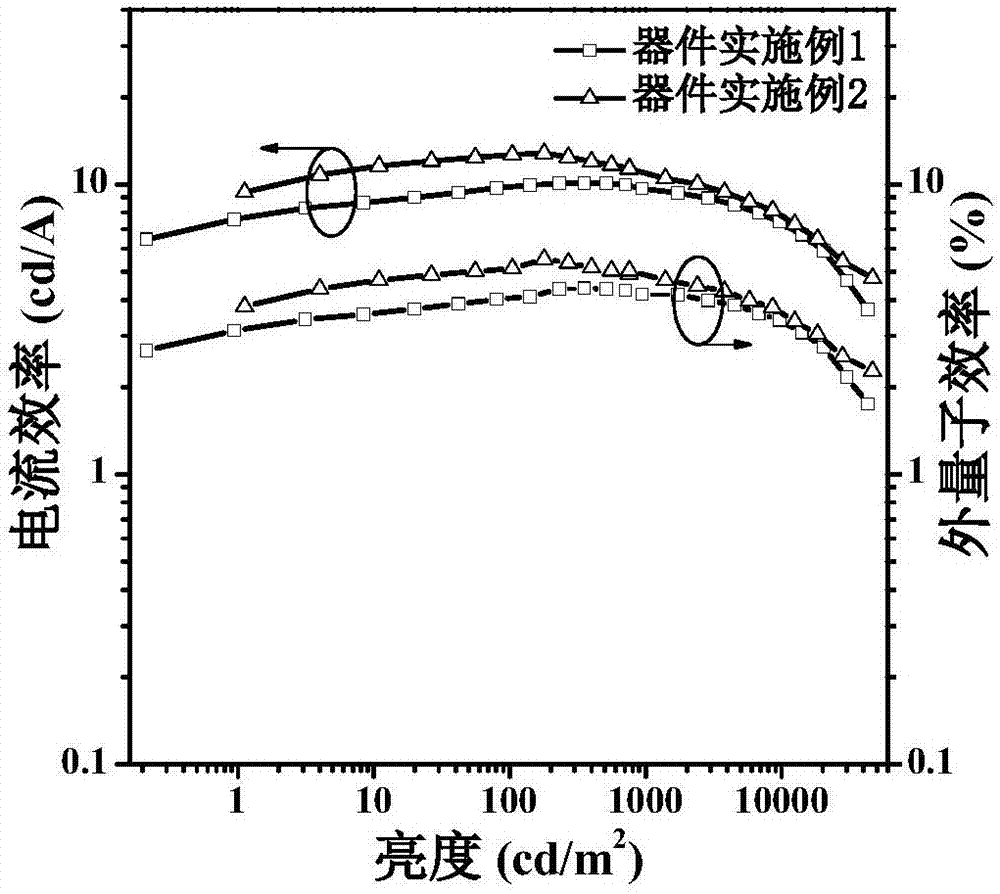Derivative containing bispyrenyl imidazole, and preparation method and application thereof
A technology of pyreneimidazole and derivatives is applied in the field of derivatives containing pyreneimidazole and the preparation thereof, and can solve the problems of unachieved luminous efficiency and the like
- Summary
- Abstract
- Description
- Claims
- Application Information
AI Technical Summary
Problems solved by technology
Method used
Image
Examples
Embodiment 1
[0079] The synthesis of embodiment 1 compound 1:
[0080] (1) Add elemental pyrene (4.02g) and sodium periodate (20g) into a 500mL round bottom flask, add 100mL distilled water and 100mL acetonitrile solution, add catalyst RuCl 3 , reacted at 30°C for 12 hours. After separation and purification, orange powdery 4,5-pyrene diquinone was obtained.
[0081] (2) Get 4,5-pyrene diquinone (2.32g), aniline (4.65g), 4-bromobenzaldehyde (5.46g) and ammonium acetate (3.85g) in a 250mL round bottom flask, under nitrogen protection, The Debus-Radziszewski reaction was performed at 120°C for 2 hours. Then distilled water was added to the reaction system, and the precipitated crude product was obtained by filtration, and 9-(4-bromo)-9-hydrogen-pyrenimidazole was obtained by separation as light yellow powder.
[0082] (3) Take 9-(4-bromo)-9-hydrogen-pyrene imidazole (4.73g), biboronic acid pinacol ester (3.81g) and newly prepared potassium carbonate solution (16mL, 2mol / L) Add to 250mL ro...
Embodiment 2
[0084] The synthesis of embodiment 2 compound 2
[0085] Step (1) was prepared according to the synthesis method of compound 1 step (1) in Example 1. Step (2) is prepared by using 4,5-pyrenediquinone, benzaldehyde and 4-bromoaniline as raw materials according to the synthesis method of compound 1 step (2) in Example 1. Step (3) is prepared by using 10-(4-bromo)-9-hydrogen-pyrenimidazole and biboronic acid pinacol ester as raw materials according to the synthesis method of compound 1 step (3) in Example 1. Step (4) is prepared according to the synthesis method of compound 1 step (4) in Example 1 using 10-(4-pinacol borate)-9-hydrogen-pyrene imidazole and 1,4-dibromobenzene as raw materials . Using MALDI-TOF to identify the compound, the molecular formula is C 64 h 38 N 4 , detected value [M+]=862.83, theoretical value 863.01.
Embodiment 3
[0086] The synthesis of embodiment 3 compound 3
[0087] Step (1) was prepared according to the synthesis method of compound 1 step (1) in Example 1. Step (2) is prepared by using 4,5-pyrenediquinone, 4-bromobenzaldehyde and aniline as raw materials according to the synthesis method of compound 1 step (2) in Example 1. Step (3) is prepared by using 9-(4-bromo)-9-hydrogen-pyrenimidazole and biboronic acid pinacol ester as raw materials according to the synthesis method of compound 1 step (3) in Example 1. Step (4) is prepared according to the synthesis method of compound 1 step (4) in Example 1 using 9-(4-pinacol borate)-9-hydrogen-pyrene imidazole and 1,4-dibromonaphthalene as raw materials . Using MALDI-TOF to identify the compound, the molecular formula is C 68 h 40 N 4 , detected value [M+]=913.24, theoretical value 913.07.
PUM
| Property | Measurement | Unit |
|---|---|---|
| luminance | aaaaa | aaaaa |
Abstract
Description
Claims
Application Information
 Login to View More
Login to View More - R&D
- Intellectual Property
- Life Sciences
- Materials
- Tech Scout
- Unparalleled Data Quality
- Higher Quality Content
- 60% Fewer Hallucinations
Browse by: Latest US Patents, China's latest patents, Technical Efficacy Thesaurus, Application Domain, Technology Topic, Popular Technical Reports.
© 2025 PatSnap. All rights reserved.Legal|Privacy policy|Modern Slavery Act Transparency Statement|Sitemap|About US| Contact US: help@patsnap.com



